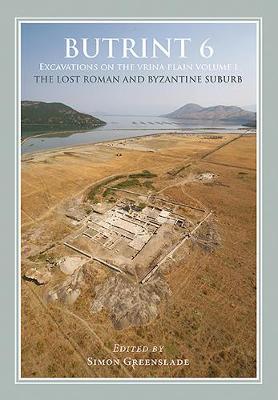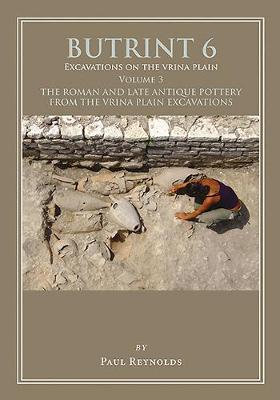Butrint Archaeological Monographs
1 primary work • 2 total works
Book 6
Butrint 6 describes the excavations carried out on the Vrina Plain by the Butrint Foundation from 2002-2007. Lying just to the south of the ancient port city of Butrint, these excavations have revealed a 1,300 year long story of a changing community that began in the 1st century AD, one which not only played its part in shaping the city of Butrint but also in how the city interacted and at times reacted to the changing political, economic and cultural situations occurring across the Mediterranean World over this period.
Volume I discusses the results from the excavations, tracing the development of the area from an early Roman bridgehead suburb during the 1st and 2nd centuries AD to a major 3rd-century domus, one of the largest of its kind in the province of Epirus Vetus, its transformation into a new residential centre dominated by a Christian basilica in Late Antiquity, to becoming the home of a Byzantine archon during the 9th and 10th centuries when it was, in all but name, Butrint, and its subsequent uses following its abandonment due to the rising water table. This is followed by a description of the domus mosaics and a detailed examination of the basilica mosaics, analysing the imagery, meaning and context of this intricate and detailed pavement, together with discussions of the Vrina Plain and its place within the story of Butrint and the wider Mediterranean World during the Roman and Byzantine periods.
Volume II discusses the finds from the Vrina Plain excavations. This volume provides an insight into how the Vrina Plain community lived, worked and ultimately died and includes chapters on the medieval and post-medieval ceramics from the excavations, analysis of the human and faunal remains, environmental evidence, Roman and Medieval coins, a detailed study of the small finds as well as a discussion of the glass including a report on a number of glass cakes, ingots of raw glass associated with glass working that were found during the excavations. The volume also reports on five lead seals dating from the late 9th to the 10th century, an uncommon find but one which when considered with the contemporary coins suggests that for 100 years the Vrina Plain was Butrint.
Volume III discusses the Roman and Late Antique pottery from the Vrina Plain excavations. This detailed study of the ceramics follows the archaeological sequence recovered from the excavations in chronological order and provides a comprehensive and in depth review of the pottery, context by context, offering an important insight into the supply, as well as typology, of local and imported pottery available to the inhabitants of the Vrina Plain during this period. This is followed by a discussion on how the pottery trends found on the Vrina Plain relate to that of other sites in Butrint, both within the town (Triconch Palace; the Forum) and outside (Vrina Plain training school villa excavations; the villa of Diaporit). The volume also presents an overview of some of the principal typological developments found across Butrint so as to allow the reader to place the Vrina finds in context, including a discussion of a number of key contexts from the Forum, as well as the findings from thin-section petrology of some of the ceramics.
Volume I discusses the results from the excavations, tracing the development of the area from an early Roman bridgehead suburb during the 1st and 2nd centuries AD to a major 3rd-century domus, one of the largest of its kind in the province of Epirus Vetus, its transformation into a new residential centre dominated by a Christian basilica in Late Antiquity, to becoming the home of a Byzantine archon during the 9th and 10th centuries when it was, in all but name, Butrint, and its subsequent uses following its abandonment due to the rising water table. This is followed by a description of the domus mosaics and a detailed examination of the basilica mosaics, analysing the imagery, meaning and context of this intricate and detailed pavement, together with discussions of the Vrina Plain and its place within the story of Butrint and the wider Mediterranean World during the Roman and Byzantine periods.
Volume II discusses the finds from the Vrina Plain excavations. This volume provides an insight into how the Vrina Plain community lived, worked and ultimately died and includes chapters on the medieval and post-medieval ceramics from the excavations, analysis of the human and faunal remains, environmental evidence, Roman and Medieval coins, a detailed study of the small finds as well as a discussion of the glass including a report on a number of glass cakes, ingots of raw glass associated with glass working that were found during the excavations. The volume also reports on five lead seals dating from the late 9th to the 10th century, an uncommon find but one which when considered with the contemporary coins suggests that for 100 years the Vrina Plain was Butrint.
Volume III discusses the Roman and Late Antique pottery from the Vrina Plain excavations. This detailed study of the ceramics follows the archaeological sequence recovered from the excavations in chronological order and provides a comprehensive and in depth review of the pottery, context by context, offering an important insight into the supply, as well as typology, of local and imported pottery available to the inhabitants of the Vrina Plain during this period. This is followed by a discussion on how the pottery trends found on the Vrina Plain relate to that of other sites in Butrint, both within the town (Triconch Palace; the Forum) and outside (Vrina Plain training school villa excavations; the villa of Diaporit). The volume also presents an overview of some of the principal typological developments found across Butrint so as to allow the reader to place the Vrina finds in context, including a discussion of a number of key contexts from the Forum, as well as the findings from thin-section petrology of some of the ceramics.
Book 6.3
Butrint 6 describes the excavations carried out on the Vrina Plain by the Butrint Foundation from 2002-2007. Lying just to the south of the ancient port city of Butrint, these excavations have revealed a 1,300 year long story of a changing community that began in the 1st century AD, one which not only played its part in shaping the city of Butrint but also in how the city interacted and at times reacted to the changing political, economic and cultural situations occurring across the Mediterranean World over this period. Volume III discusses the Roman and Late Antique pottery from the Vrina Plain excavations.
This detailed study of the ceramics follows the archaeological sequence recovered from the excavations in chronological order and provides a comprehensive and in depth review of the pottery, context by context, offering an important insight into the supply, as well as typology, of local and imported pottery available to the inhabitants of the Vrina Plain during this period. This is followed by a discussion on how the pottery trends found on the Vrina Plain relate to that of other sites in Butrint, both within the town (Triconch Palace; the Forum) and outside (Vrina Plain training school villa excavations; the villa of Diaporit).
The volume also presents an overview of some of the principal typological developments found across Butrint so as to allow the reader to place the Vrina finds in context, including a discussion of a number of key contexts from the Forum, as well as the findings from thin-section petrology of some of the ceramics.
This detailed study of the ceramics follows the archaeological sequence recovered from the excavations in chronological order and provides a comprehensive and in depth review of the pottery, context by context, offering an important insight into the supply, as well as typology, of local and imported pottery available to the inhabitants of the Vrina Plain during this period. This is followed by a discussion on how the pottery trends found on the Vrina Plain relate to that of other sites in Butrint, both within the town (Triconch Palace; the Forum) and outside (Vrina Plain training school villa excavations; the villa of Diaporit).
The volume also presents an overview of some of the principal typological developments found across Butrint so as to allow the reader to place the Vrina finds in context, including a discussion of a number of key contexts from the Forum, as well as the findings from thin-section petrology of some of the ceramics.

